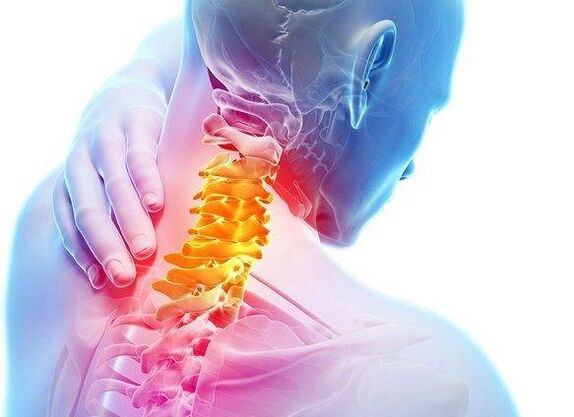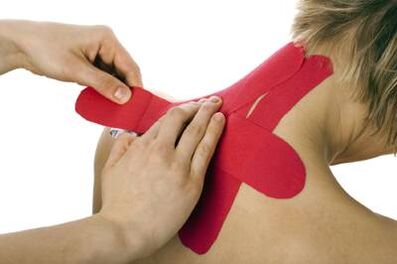The inactive lifestyle features of office workers and those who like to relax in front of the TV or behind the monitor screen often cause osteochondrosis. In this article we will consider what is cervical spinal osteochondrosis, the main cause of the disease, symptoms and stages, treatment methods, and answer other questions that occur in patients with osteochondrosis.

The osteochondrous process affects any spine or some at once. Lumbar and cervical vertebrae are most affected by the pathology, as they are most vulnerable to the burden of the anatomy of the human skeleton. The result of spinal osteochondrosis in the cervical region causes the most difficulty and complications, as its neck is a rich area of neuromus highways, most of which feed the brain directly. In addition, the nerve root, which provides the sensitivity and activity of the motor and shoulder rope, when squeezing with the destroyed vertebrate can provide a variety of symptoms.
Signs of neck osteochondrosis depends on the body's system influenced by pathology:
- The blood circulation that is disrupted by the pressure of the vertebral artery determines most complex symptoms of the brain.
- Root compression that leaves the vertebrate gives a picture of the peripheral nerve wound.
- Pining the spinal cord is associated with severe neurological pathology found in advanced cases.
Below, consider the general clinic of the cervical spinal osteochondrosis. Pain in the back of the head, neck and collar. These are the most common symptoms. The localization of pain can be expanded, affecting the shoulders, the clavicle region, chest, turning into intense head migraines. The nature of pain depends on the localization of the lesion and the severity of the pathology. Initially, the pain can be temporarily temporary, gradually becoming chronic, painful. At times of severity, pain becomes shooting, with increased neck muscle tone and limited head movements. Often, pain with cervical osteochondrosis can be localized to the back of the sternum, where many patients take these symptoms for angina pectoris.
Noise, ringing, sensation of congestion in the ear
These symptoms often participate in hearing loss. This phenomenon is associated with a decrease in blood flow from the vertebral artery to the vestibular device. Complex symptoms -these symptoms are called cochlear syndrome, or snails, and are far from always possible to determine their contact with osteochondrosis in the cervical region. Special features for differentiation are noise, congestion and ringing in the ear when changing positions, after a long stay in one position.
Dizzy
Dizziness is also caused by a violation of blood flow to the inner ear organs, which ensures the body's balance. Nystagm often joins dizziness - fluctuations in the eyes to the eyes.
Shortage
This sensation arises due to irritation of the diaphragm nerves. It is a component of the cervical nerve beam and is involved in the regulation of respiratory, depth and frequency. The patient complains about the inability to breathe in the full chest. In some cases, symptoms exacerbate shortness of breath and drowning. For the same reason, breathing stops at night and snoring. Oxygen weakness due to respiratory problems eventually leads to increased fatigue, decreased concentration and memory problems.
Nausea
It is accompanied by air. It is also caused by problems with blood circulation in some areas of the brain and ears. Nausea is sometimes observed with vomiting -prostrated by head and body movements. The result of frequent nausea and vomiting is a decrease in appetite, weight loss, alimentary failure.
Problems with vision

"Flies" in the eyes, decreased visual acuity, fog in front of the eyes - these are all symptoms caused by the ischemia of the brain area responsible for vision. Patients with osteochondrosis complain of lack of vision, as the lack of blood supply from the vertebral vessels is compensated by blood flow from the carbon artery system. Glasses and therapeutic gymnastics for the eye muscles do not solve the problem, usually the vision improves after the treatment of osteochondrosis.
Symptoms of green
Often it may be the only sign that shows cervical osteochondrosis. They are expressed as sweat, dryness and lumps in the throat, difficulty with swallowing. Symptoms are associated with compression of the nerve plexus responsible for the conservation of faring. It is necessary to distinguish such manifestations from the same clinic for inflammation or neoplasms.
How to treat cervical osteochondrosis
The spinal cord described is a very serious pathology, which, by neglect, leading to defects, and the consequences of deep disruption of the cerebral circulation, and death. For this reason, with self -medication, if the symptoms appear, you cannot do it. Osteochondrosis is treated in hospitals and at home, exclusively as prescribed by a doctor. In the early stages, the treatment of cervical osteochondrosis is conservative, which includes prescription drugs: anti -anti -anti -medication, anesthetics, medications, vitamin complexes,
During the acute period, medications are prescribed in the form of injections, when the pain decreases, the patient goes to the tablet. Physiotherapy, massage, training training, usually prescribed at the remission level, participating in drug courses. In difficult cases, osteochondrosis is treated with surgery.
The cervical spine diagram
Cervical spinal osteochondrosis (osteohaydroz) is a degenerative-dystrophic lesion of intervertebral disc, which damages the wheels, vertebral and cervical region joints, decreased intervertebral disc height is observed. The disease lasts if it is not treated, and can cause headaches, blood circulation and even hernia. Like osteoporosis, the disease is caused by a violation of mineral metabolism, as a result bone and joints become less durable. Osteochondrosis can cause cervical spinal instability (symptoms and treatment are similar to chondrosis, but have several features), which are often accompanied by vertebral displacement. On the other hand, this accelerates the development of osteochondrosis, destroying the vertebrate.
The main causes of osteochondrosis:
- improper nutrition and overweight;
- violations of posture, scoliosis, rheumatism, flat feet;
- Seditional lifestyle: inactive work (driver, office worker), lack of physical energy, and so on;
- neck injury, spinal injury;
- too much physical activity, unusual for the body;
- nerve tension, frequent pressure;
- hereditary tendency to the development of the disease;
- Improper cervical spine development.

Most of the above causes of burden on the cervical vertebra, resulting in muscle spasms. As a result, the blood circulation process is disrupted, the effectiveness of the metabolic process is reduced, resulting in degenerative changes. The intervertebral disc structure changes, they are depleted and defective, speaking outside the spine. Often the cause of osteochondrosis is a progressive disc, spread to adjacent vertebra or bone tissue. It occurs most often with prolonged physical energy in the lumbar and cervix, almost never touching the chest. Developing, osteochondrosis through several stages characterized by certain signs and symptoms. We will consider this stage below.
Osteochondrosis of the first stage of the cervical region (premature stage)
Usually, in the early stages of the development of the disease, only a small release of the neck lordosis was observed, the patient experienced an increased pain with the turn and headache, experiencing rapid and lower muscle fatigue. At this stage, osteochondrosis is cured without medication, enough to change nutrition, practice and other events.
Osteochondrosis 2 degrees
In the second stage between the vertebrae, the instability is observed, the patient begins to interfere with the pain, which periodically gives it to his hands or shoulders, the pain is also intensified with turn and head. Patients begin to see fast fatigue, absent -mindedness, reduction in performance and headache.
Osteochondrosis 3 degrees
At this stage, the pain begins to rise, it continues not only in the neck, but also on the shoulder, giving it to its hands. The hand muscles become weaker, numbness is observed, as the intervertebral disc hernia begins to form. In this case, the diagnosis reveals the small mobility of the cervical region. Patients are worried about dizziness and weakness.
Osteochondrosis 4 degrees
In the final stage, the intervertebral disc is destroyed, which is replaced by connective tissue. The pathological process affects several segments of the ridge at once, which can be at different levels of destruction. In patients, there is a violation of coordination, dizziness and increased pain, there is no sound in the ear and other disorders. Even the early stages of the disease can be identified according to the following signs:
- Headache for cervical area osteochondrosis
- pain in the neck, nape, shoulders or arms;
- Disadvantages of hand;
- Crunch and pain during head movements;
- general weakness, fatigue, impaired coordination, dizziness;
- Reduces vision and hearing skills, numbness.

One of the most common signs is dizziness for cervical spinal osteochondrosis. At the same time, dizziness symptoms can be accompanied by sound and ringing in the ear (reduced hearing loss), disorientation sensation, migraines, and nausea and vomiting. Moreover, doctors who determine how to treat these symptoms that cannot try to get rid of dizziness with folk methods. Another unpleasant consequence is frequent headaches, especially in women. Migraine can occur several times a day, causing unpleasant and painful sensations. Signs of cervical regional disease are shown in a slightly different way than other spinal osteochondrosis related to the vertebra in the neck is close to each other, the height of the intervertebral disc is small, leading to complications even with small degenerative changes.
Symptoms of cervical osteochondrosis that occur in the brain
With the development of osteochondrosis, the blood flow to the brain through the artery, which is compressed by the edges of the vertebra, decreases. As a result, there is a violation of the blood circulation of the brain. In patients, neurotic disorders are observed: irritation, anxiety, frequent mood changes, hatred, insomnia, the ability to focus is reduced. In some cases, an outbreak of anger, fear, longing may occur. Vascular cramps can cause fainting, headache, ear noise, eye appearance in front of the eyes. In this case, the symptoms of the following flow appear: dizziness, feelings of instability, nausea, in some cases of vomiting.
Treatment of cervical spinal osteochondrosis
For the treatment of diseases such as osteochondrosis, various methods are used: medications, physiotherapy, cervical zone massage for blood supply to the brain and therapeutic gymnastics, and maintain proper nutrition. Although women are more vulnerable to headaches and bodybuilding in the disease, the treatment of cervical osteochondrosis in women is not different from its treatment in men: the same medication and training are prescribed.
Diagnostic method
Experienced doctors easily diagnose cervical osteochondrosis, as the disease has a clinical picture of a feature. To determine the level, neglect and prevalence of the pathological process, some additional examinations are prescribed to the patient:
- Radiography - changes in the movement and arrangement of the vertebra, the decrease in intervertebral cracks, salt deposits are determined;
- Calculated tomography - allows to see the gap, change of disc height, vertebral instability, nerve fiber compression and spinal cord;
- Magnetic resonance imaging-allows you to see the pathological changes accurately, determining blood flow and nerve root condition.
Usually, only cervical spinal radiography is sufficient, a more expensive method is used in cases of confusing and unclear.

Physical Education Medicine
Training for cervical osteochondrosis is allowed to do strictly during forgiveness, movement in the acute phase can lead to deterioration in the patient's condition. All physiotherapy exercises are reduced to turn and head tendencies. It is important to take action slowly, without sudden movement. If you are in pain - stop the lesson and get advice on the specialist.
If a person has a tendency to develop a pathology, he or she needs to visit a specialist and have regular research. This will help identify the disease early and start treatment on time. For example, cervical osteochondrosis, the symptoms described in the article, affects the cervical vertebra and begins to destroy it literally. What is to come is, it's easy to guess.


















